Contrasts with the Republic and the European wars
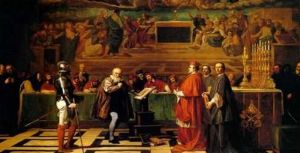 Remaining still in the sixteenth century, to create problems and damage to the City of San Remo were not enough the Plague and the Barbarian invasions, even if the victory of 1543 seemed to mitigate the bad memories of the period.
Remaining still in the sixteenth century, to create problems and damage to the City of San Remo were not enough the Plague and the Barbarian invasions, even if the victory of 1543 seemed to mitigate the bad memories of the period.
We are in the middle of the Counter-Reformation and therefore the activity of the Inquisition Tribunal, sadly known as the Holy Inquisition, which started from Spain with the even sadder character who was Torquemada's name, was claiming victims all over Catholic Europe, especially among the female population, when nothing was enough for them to be accused of blasphemy, sacrilege and witchcraft and then burnt at the stake.
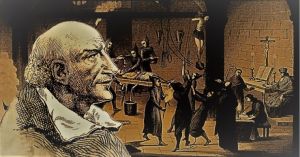
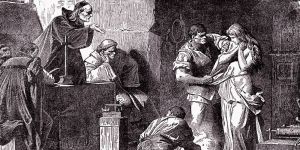 However, men were also victims, not as many as women. A document dated 24 February 1582 reports the presence of an English citizen, a certain Guglielmo Horn, « sent to Italy... as a seminar of heresy" and orders his imprisonment and delivery in such a way that "such a malignant and diabolical instrument is in the net and reaches the forces of the Holy Inquisition ».
However, men were also victims, not as many as women. A document dated 24 February 1582 reports the presence of an English citizen, a certain Guglielmo Horn, « sent to Italy... as a seminar of heresy" and orders his imprisonment and delivery in such a way that "such a malignant and diabolical instrument is in the net and reaches the forces of the Holy Inquisition ».
San Remo was no exception and here too heinous crimes were perpetrated, both for personal vendettas and for the effective credulity of the people.
On 20 October 1584, following an anonymous denunciation, Giovanni Rodi di Montalto and Enrico Brizio di Badalucco were tried in San Remo, accused of witchcraft but only the first, defined as a merchant of spells, heretic and blasphemer, was brought before the court, obviously tortured, but the final sentence and his fate are unknown. 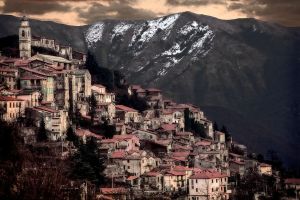 In 1588 the most frightening trial was held in Triora against thirty alleged witches: one bled to death, a certain Franchetta Borelli committed suicide by throwing herself out of the prison window, six were sentenced to death; for the others, however, despite being drained, life could be said to be over, after the torture and suffering they suffered.
In 1588 the most frightening trial was held in Triora against thirty alleged witches: one bled to death, a certain Franchetta Borelli committed suicide by throwing herself out of the prison window, six were sentenced to death; for the others, however, despite being drained, life could be said to be over, after the torture and suffering they suffered.
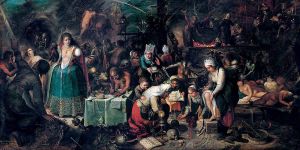 Also in San Remo, in 1547, eight women accused of witchcraft and heresy were imprisoned; but the trial, which took place in Genoa, sent them acquitted because they were victims of anonymous slander, torture and the excessive zeal of the priest Antonio Guigliero, who was suspended from his office and sent to the convent. In spite of this, even if they were innocent, out of the six women who remained, after two died from torture, the prejudices that drove them away from normal life remained, deprived them of their civil rights, andreduced their reputation so much that they were forced to leave the city, which had participated emotionally in the affair.
Also in San Remo, in 1547, eight women accused of witchcraft and heresy were imprisoned; but the trial, which took place in Genoa, sent them acquitted because they were victims of anonymous slander, torture and the excessive zeal of the priest Antonio Guigliero, who was suspended from his office and sent to the convent. In spite of this, even if they were innocent, out of the six women who remained, after two died from torture, the prejudices that drove them away from normal life remained, deprived them of their civil rights, andreduced their reputation so much that they were forced to leave the city, which had participated emotionally in the affair. Despite this climate of religious obscurantism, there was no lack of opportunities to have fun, perhaps to chase away bad thoughts. The chronicles of the time report that in February 1563, while the pirate Ulugh-Alì was still raging on the seas, a merry Carnival was celebrated in San Remo, formed by two brigades of young people, led respectively by the abbot of the Piano Michelotto Premartini and the abbot of the Castle Michelangelo Palmari.
Despite this climate of religious obscurantism, there was no lack of opportunities to have fun, perhaps to chase away bad thoughts. The chronicles of the time report that in February 1563, while the pirate Ulugh-Alì was still raging on the seas, a merry Carnival was celebrated in San Remo, formed by two brigades of young people, led respectively by the abbot of the Piano Michelotto Premartini and the abbot of the Castle Michelangelo Palmari.
The Viceroy of Provence n transit of the City, who was welcomed with great festivity, so much so that he gave a lavish gift of money to one of the two groups, and after a first grumbling, it was decided to use the sum for a lunch for both sides, just to avoid a clash between the two. From that date on it was 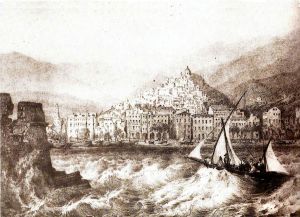 decided to organize, on the occasion of every carnival, two different masked courses that, united, concluded the festivities of the whole city.
decided to organize, on the occasion of every carnival, two different masked courses that, united, concluded the festivities of the whole city.
This tradition was kept alive until the beginning of the last century.
In spite of all the problems, still in the 16th century, commercial activities in San Remo continued to progress, with the trade of citrus fruits and palm trees, maritime traffic throughout the Mediterranean and which were the greatest source of wealth.
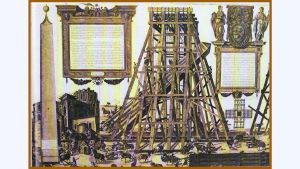 It is in these times that the well-known event of the Captain of San Remo Benedetto Bresca happened that in Rome, during the raising of the obelisk in St. Peter's Square when he shouted "aiga ae corde" that is water on the ropes to prevent the ropes from breaking.
It is in these times that the well-known event of the Captain of San Remo Benedetto Bresca happened that in Rome, during the raising of the obelisk in St. Peter's Square when he shouted "aiga ae corde" that is water on the ropes to prevent the ropes from breaking.
San Remo took part, often in spite of himself, in the great war events that devastated the century, in a Poinente that was the throat of many powerful people who found themselves in the midst of conflicts that were certainly not sought after.
 In 1625, for example, during the first war between Piedmont and France against Genoa, under the command of Vittorio Amedeo di Piemonte, the troops, once occupied Oneglia, headed for Ventimiglia which they occupied on May 26th. San Remo for its part, in anticipation of disaster, organised the feast of St. Joseph to implore the assistance of the Most High. However, he also organised the defence of the city, but this did not last long because fewer in number surrendered to the Piemontese on 17 May.
In 1625, for example, during the first war between Piedmont and France against Genoa, under the command of Vittorio Amedeo di Piemonte, the troops, once occupied Oneglia, headed for Ventimiglia which they occupied on May 26th. San Remo for its part, in anticipation of disaster, organised the feast of St. Joseph to implore the assistance of the Most High. However, he also organised the defence of the city, but this did not last long because fewer in number surrendered to the Piemontese on 17 May.
There are two versions of the episode. The first was that, with their act of submission, they avoided the usual acts of vandalism which Ventimiglia and the other villages of the hinterland were subjected to, so much so that the phrase « megliuo saria sottoposti al turco » (better would be under the Turkish) was used. The second, suggested by the chronicler Pietro Gioffredo, was that the people of Sanremo festively welcomed the occupants with citrus fruits and flowers and that, according to Grosso, « Prince Vittorio did not allow his army to damage the countryside ». Some doubt comes from the fact that after the liberation of the territory by Genoa, the Piemontese gave themselves over to the plundering of the inland villages.
The truce and then the peace of 1673 in fact left things unchanged.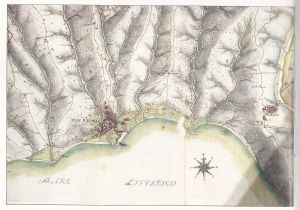 For its part, Piedmont, wanting to expand in the western part of Liguria, adopted a softer hand towards the people by favouring commercial activities, while Genoa continued its policy of tax collection and taxation of expenses for military actions. This naturally increased the discontent in its confreres, especially in San Remo, which was already reluctant to contribute, and also provoked rebellions.
For its part, Piedmont, wanting to expand in the western part of Liguria, adopted a softer hand towards the people by favouring commercial activities, while Genoa continued its policy of tax collection and taxation of expenses for military actions. This naturally increased the discontent in its confreres, especially in San Remo, which was already reluctant to contribute, and also provoked rebellions.
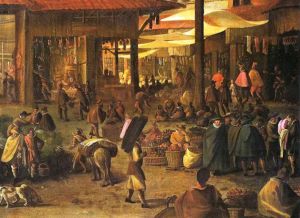 The City grew in prosperity and its numerous activities made it "attractive" for many parties in contrast to each other. Trade was growing thanks also to the opening of a weekly market since 1634.
The City grew in prosperity and its numerous activities made it "attractive" for many parties in contrast to each other. Trade was growing thanks also to the opening of a weekly market since 1634.
Naturally, Genoa did not delay in increasing its taxes, this time as a tax on soap, and knowing the riottosità of the people of Sanremo, on 6 May 1639 sent the Commssario Alessandro Saoli with the order to enforce the tax which had naturally remained unobserved.
Manoscrito Borea himself bears witness to this: « On 6 May, Mr. Alessandro Saoli, Commissioner for Measures, wishing to introduce into S. Remo orders contrary to our conventions, revolted the small people, who did little to appease them, if said Commissioner did not desist from the execution of these orders with great danger to his Person, and his Agents, and on that day it rained so much water, that women and children ran with weapons in hand, saying, long live S. Giorgio, and end the bad government ». 
Then, as always, the Republic reacted by sending 3 galleys with 500 soldiers of Corsican origin to San Remo on 13th June, and then arresting many people, confiscating goods and demolishing houses. There were condemnations that concerned the most famous and influential names of the City, some of which were heavily fined, others sent to confinement and others sentenced to heavy prison sentences. Two were finally executed on 27 July. Fortunately, the arrival of a French fleet, which also captured one of the galleys, put an end to this series of reprisals.
 Still in the situation of war between the various potentates, in 1678, King Louis XXIV, also to intimidate Spain and especially Genoa, had two naval dinghies carried out on the City of San Remo. The Borea Manuscript also tells us that on 1st August 1678, at 11 am, 26 French galleys appeared in the roadstead of San Remo. An attempt to become a member of parliament was rejected by the French, who began the cannonade, following which « there
Still in the situation of war between the various potentates, in 1678, King Louis XXIV, also to intimidate Spain and especially Genoa, had two naval dinghies carried out on the City of San Remo. The Borea Manuscript also tells us that on 1st August 1678, at 11 am, 26 French galleys appeared in the roadstead of San Remo. An attempt to become a member of parliament was rejected by the French, who began the cannonade, following which « there 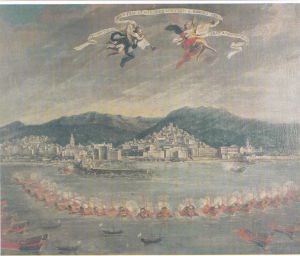 remained only one dead, two wounded young boy, Father and son with a broken leg. Above the Galleys there were 100 dead ».
remained only one dead, two wounded young boy, Father and son with a broken leg. Above the Galleys there were 100 dead ».
The register of Baptisms of the Curia of San Siro specifies that the deaths among the French were caused « by muskets and no more than eleven cannon shots from the Castle and no more damage was done to them as they were ordered not to shoot ». A painting preserved in the Borea d'Olmo palace evokes the episode; the city is depicted here with a wealth of details. The presence of the baroque bell tower of San Siro, however, assigns the painting to a period after 1753.
Naturally the French returned and again from the chronicles of the Borea Manuscript it is reported: « There were again 12 French Ships that did not salute, but around 9 p.m. fired more than 4000 canons with much damage to the City and the Campaigns and three Frenchmen died. - It is said that a Polish Prince relative of Louis fourteen, having passed through St. Remus and having been made of the Politezze, being in Paris at the Court, hearing the expedition against St. Remus, interceded the Grace for the Sovereign so that the order given to land St. Remus was countermanded. Remo ».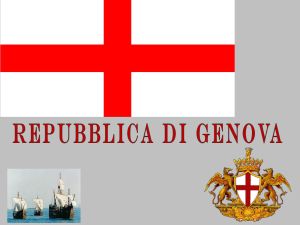 Naturally, relations with Genoa did not improve, on the contrary. The more the Republic continued to introduce new laws, the more the City opposed it. These were repeated at times. In 1663 on brandy, in 1670 on soap, in 1697 on gunpowder, in 1706 again on brandy, in 1707 again on soap and powder, in 1712 on tobacco, soap and powder; in 1714, in addition to the usual gabelle on tobacco, Genoa tried to apply an inheritance tax, in addition to the prohibition to sell or manufacture brandy or coffee in San Remo without a licence, measures that naturally did not follow. In 1717, after the umpteenth opposition to the gabella on tobacco, a Genoese shout about cards, tarot and garrellini, the most common games of the time, was rejected as « null and unfair ». With an incredible nerve, the Republic in 1718, at the protests of the San Remo people, affirmed that « it was not intended in any way to jeopardise the conditions and privileges of San Remo ».
Naturally, relations with Genoa did not improve, on the contrary. The more the Republic continued to introduce new laws, the more the City opposed it. These were repeated at times. In 1663 on brandy, in 1670 on soap, in 1697 on gunpowder, in 1706 again on brandy, in 1707 again on soap and powder, in 1712 on tobacco, soap and powder; in 1714, in addition to the usual gabelle on tobacco, Genoa tried to apply an inheritance tax, in addition to the prohibition to sell or manufacture brandy or coffee in San Remo without a licence, measures that naturally did not follow. In 1717, after the umpteenth opposition to the gabella on tobacco, a Genoese shout about cards, tarot and garrellini, the most common games of the time, was rejected as « null and unfair ». With an incredible nerve, the Republic in 1718, at the protests of the San Remo people, affirmed that « it was not intended in any way to jeopardise the conditions and privileges of San Remo ».
And in fact, in 1720, the gabella on tobacco was itroduced again, this time provoking the protest of San Remo to the Emperor.
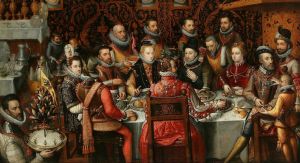 The nobleman from San Remo, Tommaso Sardi, who had been appointed consul at the Hapsburg imperial court, claimed that the City should be considered as belonging to the Empire and only in agreement with Genoa. This naturally infuriated Genoa, which issued a sentence against Sardinians in 1722, and increased its anger when it was annulled by the Emperor Charles VI, thus confirming its protection of San Remo against Genoa.
The nobleman from San Remo, Tommaso Sardi, who had been appointed consul at the Hapsburg imperial court, claimed that the City should be considered as belonging to the Empire and only in agreement with Genoa. This naturally infuriated Genoa, which issued a sentence against Sardinians in 1722, and increased its anger when it was annulled by the Emperor Charles VI, thus confirming its protection of San Remo against Genoa.
The Republic's countermeasure naturally developed in 1729 with a new introduction of the tobacco tax, this time accompanied by Commissioner Bernardo Sopranis, who was anxious to enforce it. Here too the City rebelled again under the leadership of Gerolamo Gazzano, whom the Sopranis had imprisoned but who had to hurriedly free him, given the reaction of the people, and owed him an apology. The situation was so tense that even the official cartographer of Genoa, Matteo Vinzoni, was removed from the city for topographical surveys.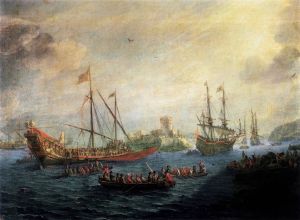
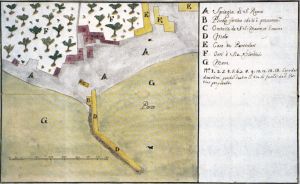 The Republic's reply was naturally of a military nature with the sending on 25 August 1729 of 4 galleys with six hundred soldiers under the command of Ansaldo Grimaldi. At first the city resisted the landings, but had to surrender after a few days. Grimaldi's behaviour was to calm the souls without reprisals, so much so that they earned him the nickname of "the Sanremese". In addition, a general amnesty brought many imprisoned citizens out of prison. This was certainly not the first intention of Grimaldi and consequently of the Republic, but this apparent benevolence was due to the secret diplomatic work of Giovanni Battista Sardi (son of the consul of the same name) who convinced the Emperor in Vienna to threaten the intervention of the troops of the King of Sardinia Vittorio Amedeo to the rescue of San Remo. The Municipality, for its part, intervened with a volume of 453 pages about the « Ragioni della Magnifica Università di San Remo contro l'eccellentissima Camera rappresenta alla Serenissima Repubblica di Genova » (Giacopazzi, Piacenza 1730), written by the lawyer Francesco Nicoli. In those years, the ariache was a clear diffidence in the confreres of Genoa.
The Republic's reply was naturally of a military nature with the sending on 25 August 1729 of 4 galleys with six hundred soldiers under the command of Ansaldo Grimaldi. At first the city resisted the landings, but had to surrender after a few days. Grimaldi's behaviour was to calm the souls without reprisals, so much so that they earned him the nickname of "the Sanremese". In addition, a general amnesty brought many imprisoned citizens out of prison. This was certainly not the first intention of Grimaldi and consequently of the Republic, but this apparent benevolence was due to the secret diplomatic work of Giovanni Battista Sardi (son of the consul of the same name) who convinced the Emperor in Vienna to threaten the intervention of the troops of the King of Sardinia Vittorio Amedeo to the rescue of San Remo. The Municipality, for its part, intervened with a volume of 453 pages about the « Ragioni della Magnifica Università di San Remo contro l'eccellentissima Camera rappresenta alla Serenissima Repubblica di Genova » (Giacopazzi, Piacenza 1730), written by the lawyer Francesco Nicoli. In those years, the ariache was a clear diffidence in the confreres of Genoa. Once again, however, San Remo was involved in a war that did not concern it directly because in 1745, as the Austrian War of Succession was going on,
Once again, however, San Remo was involved in a war that did not concern it directly because in 1745, as the Austrian War of Succession was going on,  which concerned the major crowned heads of Europe and Genoa was allied with Spain and France, the city was bombed by the sea this time by the English fleet under the command of Admiral Rodney.
which concerned the major crowned heads of Europe and Genoa was allied with Spain and France, the city was bombed by the sea this time by the English fleet under the command of Admiral Rodney.
When they appeared on 30th September in the roadstead, after the Sanremo's mediation attempts, at 9.00 p.m. the 11 ships began to bombard, continuing the following day even closer to the coast. The reaction, very little, was due to some musket shots by a small group of Spaniards who also had a dead man.
When the English fleet left the water in front of San Remo, because of a war in which it had nothing to do with it, there were only two dead in the city, but it got worse and went inland between the Nervia and Roja valleys.
The troops of the Austro-Sardinian coalition settled in Bordighera, and from there began a series of looting and violence, also demanding that San Remo contribute to the war with large sums of money, so that in 1748, having to pay 200.00 lire, the inhabitants who were unable to pay their share were subjected to the seizure of property, and even put in jail if they dared to protest. Giuseppe Grossi reports: «Suffice it to say that for the nefarious Austro-Sardinian nefariousness many Sanremo people dressed in sackclothes went to visit the churches reciting the Psalm to implore the forgiveness of sins and heavenly mercies! ». Summing up, when the war ended with the Peace of Aachen in 1748 the French-Hispanic troops passed through the West four times, three times the Austro-Sardinian ones leaving behind them signs of destruction, like the Castle of Dolceacqua and the Fort San Paolo of Ventimiglia, of violence and looting so much so that Rossi's chronicle confirms that « the campaigns of Oxentina , Sieroso , Piano di Taggia, the vegetable gardens, vineyards and the countryside beyond San Remo are murdered, and will continue to be so for many years ».
Summing up, when the war ended with the Peace of Aachen in 1748 the French-Hispanic troops passed through the West four times, three times the Austro-Sardinian ones leaving behind them signs of destruction, like the Castle of Dolceacqua and the Fort San Paolo of Ventimiglia, of violence and looting so much so that Rossi's chronicle confirms that « the campaigns of Oxentina , Sieroso , Piano di Taggia, the vegetable gardens, vineyards and the countryside beyond San Remo are murdered, and will continue to be so for many years ». Dark periods were coming to San Remo because of Genoa. After the war of the Hapsburg Succession, the Empire had lost much of its power and Maria Theresa was on the imperial throne. In 1746 an insurrection in Genoa had forced the emperors to leave the City.
Dark periods were coming to San Remo because of Genoa. After the war of the Hapsburg Succession, the Empire had lost much of its power and Maria Theresa was on the imperial throne. In 1746 an insurrection in Genoa had forced the emperors to leave the City.
Moreover, the Republic, certainly not happy with the intrusion of the Savoy into the West, decided in 1749 to send a new commissioner, Gio Battista Raggi, with the task of separating Coldirodi from Sanremo, with the excuse of a fairer distribution of military expenses. In fact, the real aim was to strengthen the dominion over the city. In the same year the Commissioner erased all traces of the Empire, demolishing its insignia and declaring the consulate finished.
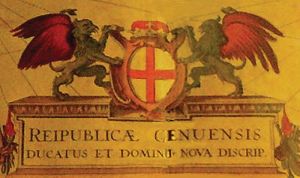 In 1752 the inhabitants of Coldirodi presented an official request to the new Commissioner Giuseppe Doria to obtain the detachment from San Remo, motivating him with alleged harassment, among which the too many taxes imposed and above all the absence of them in the municipal Parliament. Naturally, the Republic of Genoa did not expect anything else and on 1 February 1753 declared "that the men and communities of the Colla sieno and henceforth intend to be separated from the Magnifica Comunità di San Remo".
In 1752 the inhabitants of Coldirodi presented an official request to the new Commissioner Giuseppe Doria to obtain the detachment from San Remo, motivating him with alleged harassment, among which the too many taxes imposed and above all the absence of them in the municipal Parliament. Naturally, the Republic of Genoa did not expect anything else and on 1 February 1753 declared "that the men and communities of the Colla sieno and henceforth intend to be separated from the Magnifica Comunità di San Remo".
This was the spark that would ignite the powders.
(Sources: from the book "San Remo, heart and soul of a City" op.cit.; private and web images)




